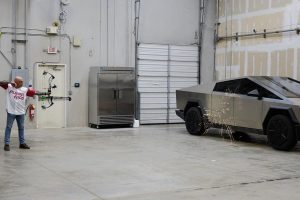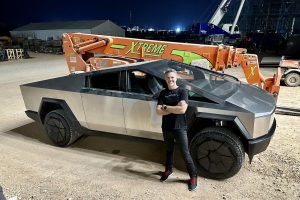Key Points
- 🚗 Tesla’s Cybertruck will feature an 800-volt architecture when deliveries begin on November 30.
- ⚡ The 800-volt architecture will lead to faster charging times, improved efficiency, better profit margins, and reduced vehicle weight.
- 💰 Tesla expects the 800-volt architecture to contribute to cost savings and boost financial performance, addressing economic challenges in the market.
- 🌐 800-volt architectures are a significant trend in the EV industry, offering advantages like faster charging and greater efficiency, not exclusive to Tesla.
- 🔌 Higher voltage systems enable efficient power transfer and reduced power loss, which is essential for EVs as they become more prevalent.
- 🏎️ Faster charging through 800-volt architectures allows for greater Supercharger outputs, reducing charging time and congestion at charging stations.
- 🔫 The Tesla Cybertruck underwent extreme bulletproof testing, demonstrating its ability to withstand gunfire, highlighting its durability and safety features.
Tesla Cybertruck will equip an 800-volt architecture when it begins deliveries on November 30, an announcement that is still fresh from the company’s Earnings Call earlier this week.
For EV newbies, the 800-volt architecture may not be much of a head-turner. However, to those who have been following the industry at all, 800v architectures are the way of the future for the EV industry, especially as more electric cars are on the road, charging times continue to be a concern to some, and heavier all-electric cars are becoming more available throughout the various automakers.
On Wednesday, Tesla confirmed what many believed for a long time: the Cybertruck would equip an 800-volt architecture.
What are the strengths of an 800-volt architecture? It comes down to charging times, efficiency, margins, and weight, all things that are important to the company and its products, as well as its financial status.
From a macro standpoint, Tesla’s financials are still strong. But Musk and Co. were not shy about warning investors and analysts about the upcoming economic headwinds it would encounter.
It’s a market-wide issue and not just a Tesla issue. As Tesla plans to launch the Cybertruck, interest rates are high, discouraging consumers from wanting to finance anything. Additionally, Musk confirmed it may take 18 months for the Cybertruck to be a positive cash flow contributor to Tesla’s financials.
The 800-volt architecture will improve margins on the vehicle instead of other EV architectures that may have been considered. It said explicitly in its Q3 Shareholder Deck:
“For very heavy vehicles, a high voltage powertrain architecture brings notable cost savings, which is why Cybertruck will adopt an 800-volt architecture.”
From a cost perspective, 800-volt architectures are void of as much copper throughout the vehicle, which reduces weight. Weight reductions improve performance and range.
Earlier today, we reported on the Cybertruck VIN Decoder, which was released by the NHTSA. It revealed the Cybertruck has two weight classifications:
“…the vehicle’s gross weight has two classes: G, which would be between 8,001 and 9,000 pounds, and H, which is between 9,001 and 10,000 pounds.”
800-volt architectures have greater efficiency because they allow electricity to move from the battery to the wheels with a lower current. This ultimately reduces the amount of power that is lost to heat, and higher voltage – lower current architectures can move the same amount of power with thinner wires, which relates to the reduction in copper that was mentioned previously.
800-volt architectures are big for the future of EVs, even outside of Teslas. Tesla EVs are far from the first cars on the market to equip an 800-volt architecture, as the Porsche Taycan had an 800v build back in 2018 when the German company unveiled the specs for its introductory EV.
Faster charging is the biggest advantage, as they can handle greater outputs from Superchargers. The V4 Supercharger from Tesla, for example, has a 350 kW output, enabled by increased amperage and current ratings.
This will keep EV owners at the Superchargers for less time, making charging more efficient and allowing more people to access chargers by decreasing congestion.





